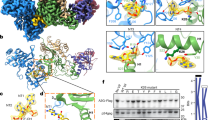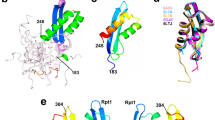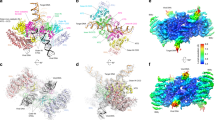Abstract
Integase interactor 1 (INI1), also known as hSNF5, is a protein that interacts with HIV-1 integrase. We report here that a cytoplasmically localized fragment of INI1 (S6; aa183–294) containing the minimal integrase-interaction domain potently inhibits HIV-1 particle production and replication. Mutations in S6 or integrase that disrupt integrase–INI1 interaction abrogated the inhibitory effect. An integrase-deficient HIV-1 transcomplemented with integrase fused to Vpr was not affected by S6. INI1 was specifically incorporated into virions and was required for efficient HIV-1 particle production. These results indicate that INI1 is required for late events in the viral life cycle, and that ectopic expression of S6 inhibits HIV-1 replication in a transdominant manner via its specific interaction with integrase within the context of Gag–Pol, providing a novel strategy to control HIV-1 replication.
This is a preview of subscription content, access via your institution
Access options
Subscribe to this journal
Receive 12 print issues and online access
$209.00 per year
only $17.42 per issue
Buy this article
- Purchase on Springer Link
- Instant access to full article PDF
Prices may be subject to local taxes which are calculated during checkout





Similar content being viewed by others
References
Pani, A. & Marongiu, M.E. Anti-HIV-1 integrase drugs: How far from the shelf? Curr. Pharm. Des. 6, 569–584 (2000).
Pommier, Y. & Neamati, N. Inhibitors of human immunodeficiency virus integrase. Adv. Virus Res. 52, 427–458 (1999).
Mathe, C. & Nair, V. Potential inhibitors of HIV integrase. Nucleosides Nucleotides 18, 681–682 (1999).
Asante-Appiah, E. & Skalka, A.M. Molecular mechanisms of retroviral DNA integration. Antiviral Res. 36, 139–156 (1997).
Brown, P.O. Integration of retroviral DNA. Curr. Topics Microbiol. Immunol. 157, 19–48 (1990).
Desrosiers, R.C. Strategies used by human immunodeficiency virus that allow persistent viral replication. Nature Med. 5, 723–725 (1999).
Brown, P. Integration. in Retroviruses (eds. Coffin, J.M., Hughes, S.H. & Varmus, H.E.) 161–203 (Cold Spring harbor Laboratory Press, Cold Spring Harbor, New York, 1997).
Engleman, A., Englund, G., Orenstein, J.M., Martin, M.A. & Craigie, R. Multiple effects of mutations in human immunodeficiency virus type 1 integrase on viral replication. J. Virol. 69, 2729–2736 (1995).
Masuda, T., Planelles, V., Krogstad, P. & Chen, I.S.Y. Genetic analysis of human immunodeficiency virus type 1 integrase and the U3 att site: Unusual phenotype of mutants in the zinc finger-like domain. J. Virol. 69, 6687–6696 (1995).
Wu, X. et al. Human immunodeficiency virus type 1 integrase protein promotes reverse transcription through specific interactions with the nucleoprotein reverse transcription complex. J. Virol. 73, 2126–2135 (1999).
Leavitt, A.D., Robles, G., Alesandro, N. & Varmus, H.E. Human immunodeficiency virus type 1 integrase mutants retain in vitro integrase activity yet fail to integrase viral DNA efficiently during infection. J. Virol. 70, 721–728 (1996).
Nakamura, T. et al. Lack of infectivity of HIV-1 integrase zinc finger-like domain mutant with morphologically normal maturation. Biochem. Biophys. Res. Commun. 239, 715–722 (1997).
Kalpana, G.V., Marmon, S., Wang, W., Crabtree, G.R. & Goff, S.P. Binding and stimulation of HIV-1 integrase by a human homolog of yeast transcription factor SNF5. Science 266, 2002–2006 (1994).
Morozov, A., Yung, E. & Kalpana, G. Structure-function analysis of integrase interactor 1L1 reveals differential properties of two repeat motifs present in the highly conserved region. Proc. Natl. Acad. Sci. USA 95, 1120–1125 (1998).
Versteege, I. et al. Truncating mutations of hSNF5/INI1 in aggressive paediatric cancer. Nature 394, 203–206 (1998).
Biegel, J.A. et al. Germ-line and acquired mutations of INI1 in atypical teratoid and rhabdoid tumors. Cancer Res. 59, 74–79 (1999).
Wang, W. et al. Purification and biochemical heterogeneity of the mammalian SWI-SNF complex. EMBO J. 15, 5370–82 (1996).
Kingston, R.E. & Narlikar, G.J. ATP-dependent remodeling and acetylation as regulators of chromatin fluidity. Genes Dev. 13, 2339–52 (1999).
Naldini, L. et al. In vivo gene delivery and stable transduction of nondividing cells by a lentiviral vector. Science 272, 263–267 (1996).
Leung, D.W., Chen, E. & Goeddel, D.V. A method for random mutagenesis of a defined DNA segment using a modified polymerase chain reaction. Techique 1, 11–15 (1989).
Wu, X. et al. Functional RT and integrase incorporated into HIV-1 particles independently of the Gag/Pol precursor protein. EMBO J. 16, 5113–22 (1997).
Adachi, A. et al. Generation and characterization of human immunodeficiency virus type 1 mutants. Arch. Virol. 117, 45–58 (1991).
Ansari-Lari, M.A., Donehower, L.A. & Gibbs, R.A. Analysis of human immunodeficiency virus type 1 integrase mutants. Virol. 211, 332–335 (1995).
Cannon, P.M., Wilson, M., Byles, E., Kingsman, S.M. & Kingsman, A.J. Human immunodeficiency virus type 1 integrase: Effect on viral replication of mutations at highly conserved residues. J. Virol. 68, 4768–4775 (1994).
Gallay, P., Swingler, S., Song, J., Bushman, F. & Trono, D. HIV nuclear import is governed by the phosphotyrosine-mediated binding of matrix to the core domain of integrase. Cell 83, 569–576 (1995).
Stevenson, M., Stanwick, T.L., Dempsey, M.P. & Lamonica, C.A. HIV-1 replication is controlled at the level of T cell activation and proviral integration. EMBO J. 9, 1551–1560 (1990).
Wiskerchen, M. & Muesing, M.A. Human immunodeficiency virus type 1 integrase: Effects of mutations on viral ability to integrate, direct viral gene expression from unintegrated viral DNA templates, and sustain viral propagation in primary cells. J. Virol. 69, 376–386 (1995).
Fletcher, T.M., 3rd et al. Complementation of integrase function in HIV-1 virions. EMBO J. 16, 5123–38 (1997).
Muchardt, C., Sardet, C., Bourachot, B., Onufryk, C. & Yaniv, M. A human protein with homology to Saccharomyces cerevisiae SNF5 interacts with the potential helicase hbrm. Nucleic Acids Res. 23, 1127–32 (1995).
Ott, D.E. et al. Cytoskeletal proteins inside human immunodeficiency virus type 1 virions. J. Virol. 70, 7734–7743 (1996).
Bukovsky, A. & Gottlinger, H. Lack of integrase can markedly affect human immunodeficiency virus type 1 particle production in the presence of an active viral protease. J. Virol. 70, 6820–6825 (1996).
Swanstrom, R. & Wills, J.W. Synthesis, assembly, and processing of viral proteins. in Retroviruses (eds. Coffin, J.M., Hughes, S.H. & Varmus, H.E.) 263–334 (Cold Spring Harbor Laboratory Press, Cold Spring Harbor, New York, 1997).
Cheng, S.-W. G. et al. c-MYC interacts with INII/hSNF5 and requires the SWI/SNF complex for transactivation function. Nature Gen. 22, 102–105 (1999).
Acknowledgements
We thank V.R. Prasad and J. Brojatsch for critically reading the manuscript; R. Kim, R. Beltran, S-W. G. Cheng and P. Joshi for technical help; D. Helland and D. Trono for reagents; S. Goff for helpful discussions; and A. Rubinstein, Y. Mizrachi, M. Mantovani, G. Liu and N. Sokolov for assistance with the p24 ELISA assays. This work was funded by a NIH grant AI/GM 399951 to G.V.K. and a contract NOI-CO-56000 to D.O. M.S. and A.P. were funded by an institutional training grant T32-AI07501
Author information
Authors and Affiliations
Corresponding author
Rights and permissions
About this article
Cite this article
Yung, E., Sorin, M., Pal, A. et al. Inhibition of HIV-1 virion production by a transdominant mutant of integrase interactor 1. Nat Med 7, 920–926 (2001). https://doi.org/10.1038/90959
Received:
Accepted:
Issue Date:
DOI: https://doi.org/10.1038/90959
This article is cited by
-
INI1/SMARCB1 Rpt1 domain mimics TAR RNA in binding to integrase to facilitate HIV-1 replication
Nature Communications (2021)
-
Inhibition of nuclear export restores nuclear localization and residual tumor suppressor function of truncated SMARCB1/INI1 protein in a molecular subset of atypical teratoid/rhabdoid tumors
Acta Neuropathologica (2021)
-
Identification of interaction between HIV-1 glycoprotein 41 and integrase
Virologica Sinica (2016)
-
INI1/hSNF5-interaction defective HIV-1 IN mutants exhibit impaired particle morphology, reverse transcription and integration in vivo
Retrovirology (2013)
-
Flavivirus NS3 and NS5 proteins interaction network: a high-throughput yeast two-hybrid screen
BMC Microbiology (2011)



